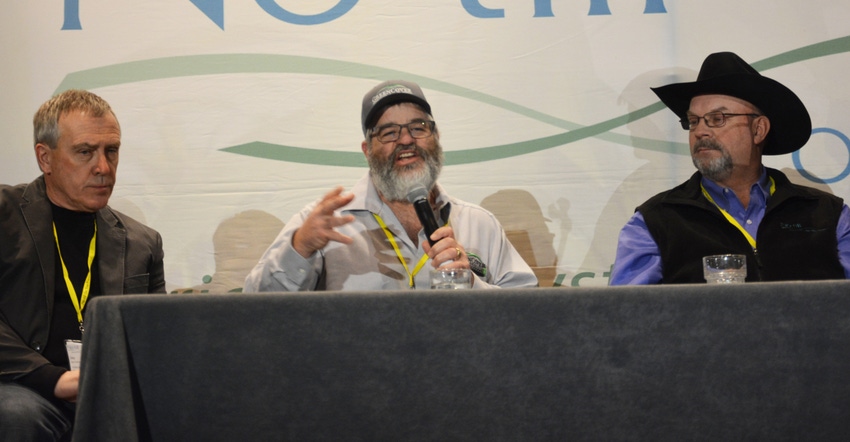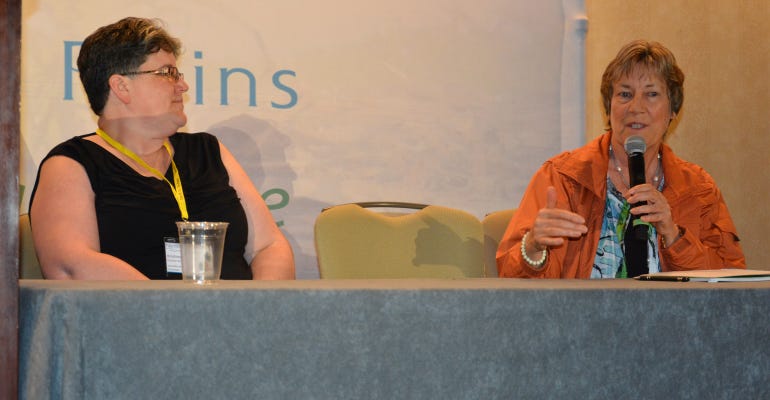
When you talk to the folks who are active in no-till farming practices and the movement to cover crops as part of a soil health effort, there’s a business that stands out among the premiere entrepreneurs of the movement: Green Cover Seed of Bladen, Neb., and the Berns brothers, Keith and Brian.
For most practitioners, it may come as a surprise that Green Cover Seed is only 10 years old. Yes, it has really only been 10 years since the cover crop and soil health movement started.
At the 2019 No-till on the Plains Winter Conference, the Berns brothers were part of a panel to discuss the last 10 years and what has been learned as well as looking forward to what may be coming next.
As facilitator of the panel, Keith Berns gave a history of Green Cover Seed, starting with a SARE grant in 2008 to study cover crops and moisture usage. In 2009, Green Cover Seed began selling premixed seed and in that initial year sold enough for about 2,000 acres of cover crops.
In 2010, the Berns brothers bought a mixer and sold about 25,000 acres of seed. In 2011, they built a seed building, and in 2012 they added more buildings and bins. By 2013, they were adding onto the first building for more bulk stage, and they sold seed for about 330,000 acres.
In 2014, Green Cover Seed added mixing and bagging equipment and continued expanding operations. In 2015, they sold seed for 460,000 acres and in 2016 the company added more employees and sold seed for about 560,000 acres. In 2017, acreage was up to 600,000 acres and in 2018 it expanded to 825,000 acres of seed sold, 35 full-time employees and 8,000 customers in 70 states, provinces or countries.
Soil health progress
Oklahoma farmer and panelist Jimmy Emmons said that history is a reminder that no-tillers should realize that the soil health movement is making progress.
“We get discouraged thinking we aren’t making progress, then you come to a meeting like this and hear about that kind of growth and it’s very encouraging,” he said.
Christine Nichols, who is a veteran of the Rodale Institute and now owns a consulting business, was also a panelist. She said she moved to North Dakota 15 years ago and quickly gained an education about soil health and the role cover crops play. “It’s now about getting out there and sharing the knowledge we have gained,” she said.
Christine Jones, a preeminent soil microbiologist in Australia, told the panel that her interest in soil health and cover crops goes back 30 years to the introduction of holistic farming.
“I’ve been just blown away by the change that has been achieved. The increase in carbon in the soil has been amazing,” she said. “In Australia, academia is still behind the curve. Most of the education I’ve gotten has been from farmers and for researchers like Jill Clapperton who taught me about mycorrhizal fungi. I am so grateful for the education they have provided.”
 PROMISING FUTURE: Soil health consultant Christine Nichols (left) listens to remarks from Christine Jones, a preeminent soil microbiologist from Australia, during a presentation at this year’s No-till on the Plains Winter Conference.
PROMISING FUTURE: Soil health consultant Christine Nichols (left) listens to remarks from Christine Jones, a preeminent soil microbiologist from Australia, during a presentation at this year’s No-till on the Plains Winter Conference.

Emmons said that, as recently as 2012, most of the conversation was about plants and their growth and yields of grain without much talk about what was happening below the surface of the soil and how that impacted plants.
Brian Berns said his introduction came from a bus trip to South Dakota to get acquainted with Dwyane Beck, manager of Dakota Lakes Research Farm in Pierre.
Jay Furher, with the Natural Resources Conservation Service in Oklahoma, said he too found a mentor in Beck. “I feel lucky to have found somebody to be a teacher that I could turn when I was stuck,” Furher said. "He got us rolling with understanding how soil health works.”
Jones said that conventional wisdom has long been that Australia has poor soil that is just low in phosphorus and that nothing can be done to improve, let alone create, topsoil. But things are changing, and a huge amount of soil is being built. On-the-farm data that farmers are supplying are showing that.
Nichols said that, in soil health as in other areas, often the most innovation comes at the point where stress is the greatest. “That is especially true in areas where there is water stress,” he said. “The closer to the edge you get, the stronger the push for change.”
Brian Berns said it is time for no-tillers to stop worrying about what their neighbors think and go right ahead and put no-till and cover crops “out on the highway.”
“Let your mind run,” he said. “Farmers are the true innovators. I encourage you to keep going.”
The panelists agreed that the soil health movement is nearing a tipping point and that rapid progress is coming
“We’re beginning to really understand how soil health impacts human health,” Nichols said. “We seeing so may ties between the bacteria in the soil and the bacteria in the human gut. Farmers have traditionally seen themselves as producers of commodities. We need to change the mindset to make more people understand they are producers of food. That will lead to a revolution and a transformation.”
Emmons said he thinks increasing consumer awareness will bring great change in the next decade.
“The consumers are becoming aware of the impact of environment on their lives. Air quality, water quality, soil quality and human health are all connected. Pressure from consumers will pull more producers into the movement.”
About the Author(s)
You May Also Like






